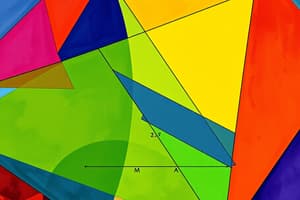Podcast
Questions and Answers
What is the key concept to remember when measuring perimeter?
What is the key concept to remember when measuring perimeter?
Perimeter is a number with a unit, like 10 cm or 25 miles.
What is the best way to visualize perimeter of a shape?
What is the best way to visualize perimeter of a shape?
Imagine walking along the edge of a shape, like a 5-sided polygon, and the total distance traveled would be the perimeter.
Why is perimeter considered a 1-dimensional quantity?
Why is perimeter considered a 1-dimensional quantity?
Because it's the distance of the lines that go around a 2-dimensional shape.
How can you find the perimeter of a polygon?
How can you find the perimeter of a polygon?
Signup and view all the answers
What is important to remember when finding the perimeter of a polygon?
What is important to remember when finding the perimeter of a polygon?
Signup and view all the answers
Study Notes
-
Perimeter is a 1-dimensional quantity that measures the distance around a shape, and it can be measured with units like centimeters, inches, or miles.
-
The units of measurement are crucial when talking about perimeter, and it's not just a number, but a number with a unit, like 10 cm or 25 miles.
-
Perimeter means the absolute shortest distance possible around a shape, which is the distance you'd get if you traced the path exactly around the border or edge of a shape.
-
A good way to understand perimeter is to imagine walking along the edge of a shape, like a 5-sided polygon, and the total distance traveled would be the perimeter of that shape.
-
Another way to visualize perimeter is to imagine taking a shape, like a square, and breaking it at one of its corners, then unfolding it until it forms a straight line, and the length of that line is the perimeter of the shape.
-
Perimeter is 1-dimensional because it's the distance of the lines that go around a 2-dimensional shape.
-
Finding the perimeter of shapes with curves, like circles or hearts, can be tricky and will be discussed in another video.
-
The perimeter of polygons can be easily found by adding up the lengths of all their sides, since polygons are made from only straight sides.
-
When finding the perimeter of a polygon, always remember to include the units of measurement, like centimeters or meters.
-
The formula for finding the perimeter of a regular polygon is to multiply the number of sides by the length of the sides, which works for any regular polygon, regardless of the number of sides.
-
When dealing with problems where not all the information is given, use what you do know to figure out what you don't know, and use the given information to find the missing lengths.
Studying That Suits You
Use AI to generate personalized quizzes and flashcards to suit your learning preferences.
Description
Learn about the concept of perimeter, its units of measurement, and how to calculate it for different shapes, including polygons and regular polygons. Understand the formula for finding the perimeter of a regular polygon and how to solve problems with missing information.




